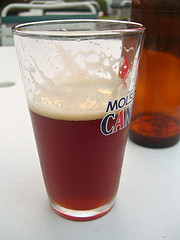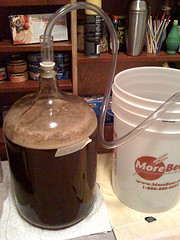
Fermenting barleywine
I haven’t yet compiled a list of my top 10 beers, but if I did, Lost Abbey Angel’s Share would definitely be on it. I first tasted it at the 2010 Barleywine Festival at Toronado, and it was love from the first sip. The intense, rich maltiness, full body, and surprisingly dry finish — enhanced by the bourbon, oak, and vanilla character developed by aging it in Heaven Hill Wheat Whiskey barrels — make it a beer to savored and appreciated, especially at the end of the day in the company of good friends.
Here in California, we are sometimes lucky enough to find Angel’s Share on draft, and it might even be better than the bottled version. I even love the name, which refers to the portion (share) of a wine or spirit’s volume that is lost to evaporation during aging in the barrels.
Needless to say, I really want to brew a beer approaching this greatness.
The reason is not even economics. A small (375 ml) bottle of Angel’s Share goes
for around $16-18 locally, but I consider that a fair price, given the
ingredients, effort, and time that goes into its making. I would simply like to
extend my skills, learn, and, in the process, hopefully brew a great beer.
Now, there are a few obstacles. First, Lost Abbey does not release the base beer that goes into the bourbon barrels, and there is virtually no information on its composition, aside from a note on the website that it is “brewed with copious amounts of dark caramel malt.” Sources say that it is an English-style barleywine, an Imperial brown ale, or an American strong ale, so developing a clone recipe is a challenge. Second, I don’t have a bourbon barrel to age the beer in, and even if I did, the logistics of brewing 55 gallons of beer, fermenting, aging it a year, and then bottling over 300 bombers (22-oz bottles) are, shall we say, formidable. The closest thing a homebrewer can do to simulate this process is use oak cubes and then add some bourbon at bottling time.
Unable to find a clone recipe of the base beer, I decided to use the recipe from The Mad Fermentationist, who said that it was “inspired by, but not a clone of, Angel’s Share.” I am still learning how to craft beers from scratch, but I couldn’t stay away from tweaking his recipe anyway. I removed the Crystal 55L malt, cut the wheat malt by two thirds, added a good amount of Munich malt, and a bit of Carafa II Special. Whether that was a mistake or not will be shown by the end result. All of the hops I used were leftovers that I’ve been keeping in the fridge, so the alpha acid percentage had to be adjusted down, somewhat. A beer like this doesn’t really need much hop character, so a variety of hops can be used for bittering.
I also decided to brew a smaller batch, since the recipe is very experimental, and I don’t really need 5 gallons of 11% barleywine. An added bonus was that I could brew it on my stovetop, and ferment it in a 3-gallon Better Bottle.
Since this would be the biggest (highest ABV) beer I’ve ever brewed, I wanted to do it properly to ensure that the fermentation doesn’t get stuck halfway. To help with this, I made a 1.5 L starter from a very fresh vial of WLP001 yeast. I also followed the advice in How to brew a really BIG beer article, which suggests doing a long 146/149°F to 154/156°F step mash to make a very fermentable wort. For some reason, I thought that raising the mash temperature by decoction was a good idea. It wasn’t. The decoction boiled, but after adding it back to the main mash, the temperature hardly increased, so I had to improvise. More in the notes.
Given my recipe hacking and the troubles I encountered, I doubt this will be close to Angel’s Share, but I still hope it will be an enjoyable barleywine.
Angel’s Share Experiment
Overview
――――――――
Type: All-grain
Batch Size: 2.5 gal
Total Grain: 9.72 lbs
Expected OG: 1.102
Expected SRM: 22.6
Expected IBU (Rager): 82.1
Brewhouse Efficiency: 75%
Wort boil time: 120 min
Fermentation Temperature: 67°F
Fermentables
————————————
6.75 lbs. Maris Otter 66.1%
1.75 lbs. Munich 10L Malt (US) 17.1%
0.32 lbs. White Wheat Malt 3.1%
0.32 lbs. CaraVienna Malt (Belgium) 3.1%
0.32 lbs. CaraMunich Malt (Belgium) 3.1%
0.13 lbs. Special B Malt (Belgium) 1.2%
0.09 lbs. Chocolate Malt (US) 0.9%
0.06 lbs. Carafa II Special (Germany) 0.6%
0.25 lbs. Sugar – Muscovado 4.9%
Hops
————
0.6 oz. Galena [13.8% AA, pellet] @ 60 min.
0.4 oz. Challenger [6.5% AA, pellet] @ 30 min.
0.4 oz. Cascade [6.5% AA, pellet] @ 30 min.
Extras
——————
1 Whirlfloc tablet @ 15 min.
1 Servomyces yeast nutrient tablet @ 10 min.
0.8 oz American/Hungarian oak cubes secondary
Yeast
—————
White Labs WLP001 – California Ale
Water Profile
—————————————
San Francisco tap
Mash Schedule
—————————————
Type: step mash
Saccharification rest: 45 min. @ 147°F
Saccharification rest: 60 min. @ 155°F
Notes
6/19/10
Brew day, by myself.
Got some dough balls when mashing in, but the temp was 147°F exactly. After 15 minutes, pulled 3 quarts of medium-thickness mash into the kettle, and raised temp to 154°F and held 15 minutes for conversion.
Realized the chocolate malt I added from a leftover bag was uncrushed, so substituted 2.25 oz of crushed pale chocolate malt instead. Raised decoction temp to boiling, boiled for 15 minutes. Added back to the mash tun, but the temperature didn’t seem to go up at all. Infused 3 quarts of boiling water (by infusion calculator), temperature rose to only 151°F. Decided to leave at that, because adding more water would give me more than the desired boil volume. Mashed for another 40 minutes. Collected 3.75 gallons of 1.063 SG wort. Did a sparge with 1 quart to get more sugars out. Added after 30 minutes of the main boil. Obviously, the efficiency suffered a bit with such a small sparge.
Extended pre-hops boil by 30 minutes to evaporate more. Decided to add second batch of hops at -20 minutes to bring down IBUs a tad. Added muscovado sugar at flameout.
Chilled to 70°F, transferred to fermenter. Pre-pitch volume was 2.3 gallons. Aerated well by shaking, then pitched the active starter (made the night before). Placed in cooler with ice pack. Signs of fermentation (krausen and airlock) after only 2.5 hours.
6/20/10
Good strong fermentation going by morning, nice thick krausen. Temp is staying around 64°F.
6/21/10
Realized that Beer Alchemy was set to Tinseth formula instead of Rager while I was tweaking the IBUs, so most likely I over-bittered the barleywine. Womp womp. Dropped 6 oak cubes (3 American, 3 Hungarian) into the carboy.
6/22/10
Swirled the carboy to expel sulfur. Blowoff followed shortly, so attached a blowoff tube.
6/27/10
Temperature is up to 69°F. Gravity is down to 1.019.
7/7/10
Racked to the secondary on top of 0.8 oz of Hungarian-American oak cube mixture that’s been soaking in bourbon.
8/6/10
After a month on oak, the wood character is definitely present. The bitterness is there, but not overwhelming. Probably best to bottle soon.
8/15/10
Bottled with 1.5 oz of dextrose.





![Reblog this post [with Zemanta]](http://img.zemanta.com/reblog_c.png?x-id=e9adf3c1-74b8-4f6b-9fb2-441b8845b5fc)
